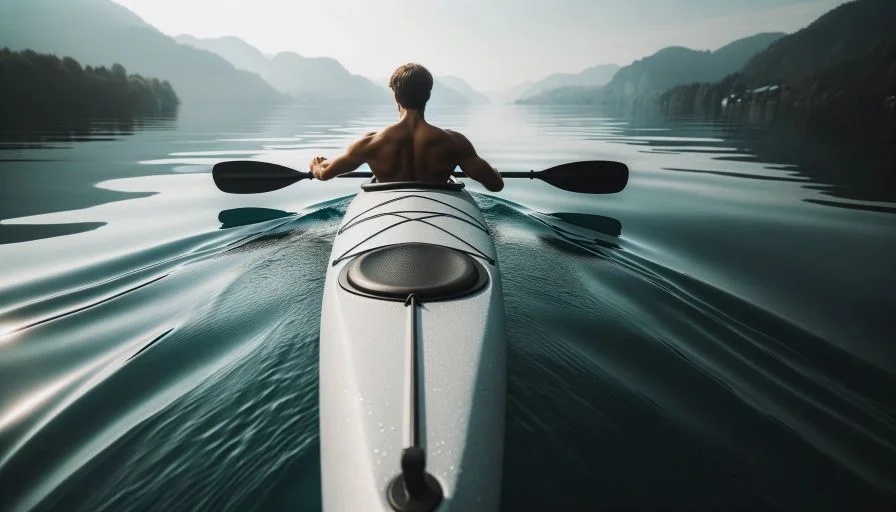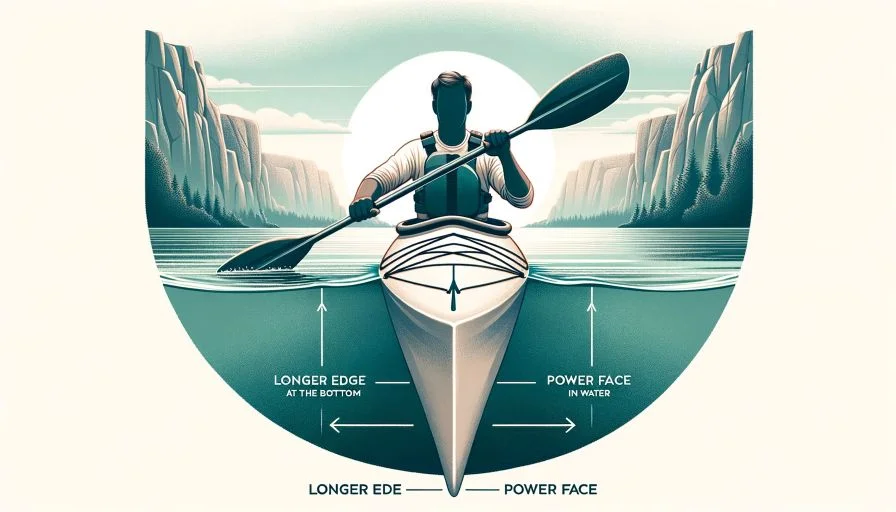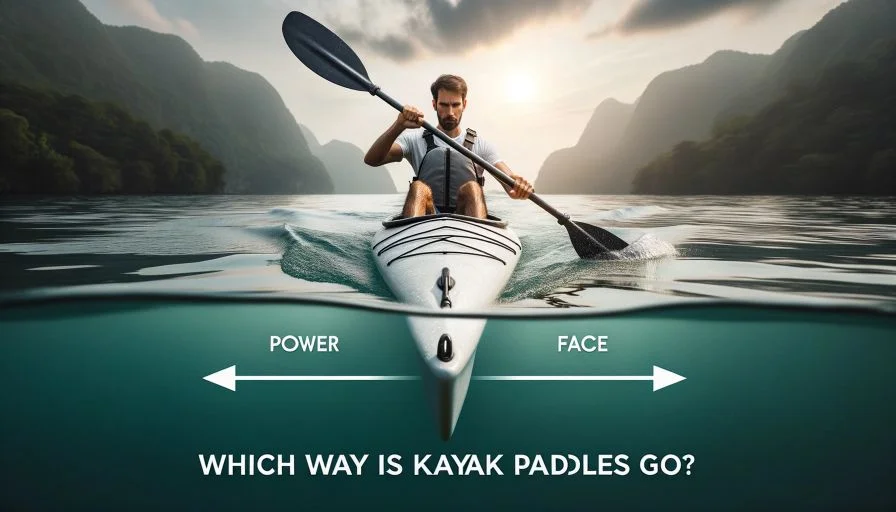Embarking on a kayaking journey demands not just enthusiasm but also the knowledge of using your equipment correctly. One question that frequently surfaces, especially among beginners, is: “Which way do kayak paddles go?” To provide a straightforward answer: the longer edge of the asymmetrical blade should be at the bottom, and the power face should face the water when paddling.
While this gives a direct solution, the orientation and use of kayak paddles encompass more nuances that can significantly enhance your paddling experience. This article will elaborate on these details, ensuring you can navigate waters with ease and efficiency.
Understanding the Basics of a Kayak Paddle
Components of a Kayak Paddle
Before diving into the correct orientation, let’s break down the kayak paddle’s main components:
- Blade: The wide, flat part of the paddle that enters the water.
- Shaft: The long, cylindrical part of the paddle that you hold.
- Control Grip: The area of the shaft that is designed to be gripped by the paddler, ensuring a comfortable and effective hold.
- Power Face: The side of the blade that pushes against the water when paddling.
By understanding each part’s function, you can better grasp how the paddle should be oriented during your paddling endeavors.
Asymmetrical Blades and Their Significance

Modern kayak paddles often feature asymmetrical blades, meaning that one side of the blade is longer than the other. Why is this significant?
- Efficiency in the Water: Asymmetrical blades are designed to move more smoothly and efficiently through the water.
- Reduced Flutter: The unique design reduces the fluttering or vibration that can occur during paddle strokes.
- Enhanced Maneuverability: Allows for quicker turns and more precise movements in the water.
When holding an asymmetrical paddle, you’ll notice a long edge and a short edge. Recognizing these edges will aid in understanding the paddle’s correct orientation.
Orientation and Positioning of the Kayak Paddle
Now, let’s address the burning question: Which way do kayak paddles go?
- Blade Positioning: The shorter edge of the asymmetrical blade should be on the top, while the longer edge is on the bottom. This orientation ensures the paddle enters the water smoothly, maximizing each stroke’s efficiency.
- Control Grip and Shaft: Your control grip should be oriented so your knuckles align with the blade’s top edge. The shaft should be held with a relaxed grip, hands positioned equidistant from each blade.
- Angled Blade: Some paddles feature an angled blade, meaning one blade is tilted compared to the other. If you have such a paddle, the forward-facing or upward blade should have the top edge (short edge) tilting slightly away from you. This design aids in “feathering” paddle strokes, reducing resistance from the wind.
The Importance of the Correct Grip
Paddling efficiently isn’t just about the paddle’s orientation; it’s also about how you hold it.
- Position Your Hands Correctly: Your hands should be about shoulder-width apart on the shaft, ensuring a balanced and efficient paddle stroke.
- Firm but Relaxed Grip: Holding the shaft too tightly can lead to fatigue. Instead, maintain a firm yet relaxed grip, allowing for fluid movement.
- Alignment: Ensure your hands are aligned with the power face of the blade. This ensures that when you take a stroke, the blade’s power face makes proper contact with the water.
Perfecting the Orientation and Technique of Kayak Paddling

Revisiting Paddle Orientation for Effective Paddling
The importance of how you position and hold your paddle can’t be stressed enough. Every kayak enthusiast needs to ensure that their paddle’s orientation complements their strokes, making each movement effective and efficient.
- Reaffirming Blade Positioning: With asymmetrical blades, the longer edge should always be at the bottom. This ensures that the blade slices into the water smoothly, reducing resistance and maximizing each paddle stroke.
- Control Grip Nuances: Continuously check the alignment of your control grip with the top edge of the blade. This periodic check will ensure that your power face is always correctly oriented, making your paddling more effective.
Paddling with Asymmetrical Blades
As touched upon in Part 1, asymmetrical blades are designed for a reason. Here’s how they influence your paddling technique:
- Improved Reach and Pull: The longer edge of the blade at the bottom lets you reach deeper into the water, offering a more powerful pull.
- Refined Control: The short edge at the top of the blade gives better surface control, particularly during maneuvers.
- Optimized Angle: Remembering the “angled blade” design, where the blade is slightly slanted? This angling is perfect for feathering paddle strokes, ensuring minimal wind resistance and smooth transitions.
The Role of the Shaft in Paddling

The shaft isn’t just a connector between the two blades. Its proper grip and orientation can make a world of difference in your paddling:
- Balanced Grip: Holding the shaft equidistant from each blade ensures balanced and symmetrical strokes.
- Using the Shaft’s Flex: Some paddle shafts are slightly flexible. By ensuring a proper grip and orientation, you can use this flex to your advantage, adding power to your paddle strokes without added effort.
The Confluence of Blade and Paddle Strokes
Your blade’s orientation directly impacts the quality of your paddle strokes. Remember:
- Forward Stroke with the Power Face: Ensure the blade’s power face is directed correctly, facing the water during a forward stroke. This guarantees optimal push and minimal water splashing.
- Utilizing the Short Edge: When executing quick, shallow strokes, the blade’s short edge can be utilized for speed and responsiveness.
The Importance of the Control Grip in Paddle Strokes
The control grip isn’t just about comfort; it’s integral for efficient paddle strokes:
- Ensuring Proper Grip: Your control grip should be oriented so that the knuckles align with the blade’s top edge. This ensures that when you take a stroke, the blade’s power face makes proper contact with the water, optimizing each movement.
- Avoiding Fatigue: A correct grip and orientation, combined with the benefits of the control grip, can reduce early fatigue and ensure longer, more enjoyable paddling sessions.
Conclusion
By now, you should have a solid understanding of the kayak paddle’s basic components and how they influence its orientation and usage. The emphasis on asymmetrical blades, their orientation, and the importance of a correct grip paves the way for efficient and effective paddling.
The nuances of kayak paddle orientation—whether it’s the long edge of the blade, the power face, or the control grip—play a pivotal role in the efficiency and enjoyment of your paddling experience. By mastering these intricacies, not only do you ensure a smooth ride but you also elevate your kayaking prowess. The art of paddling, with its myriad strokes and techniques, begins with a foundational understanding of the paddle’s orientation. The journey ahead is filled with splashes of fun and waves of adventure. Happy paddling!
Read More:
- What Size Kayak Paddle Do I Need?
- DIY Floating Cooler for Kayak
- How to Hold a Kayak Paddle?
- How to Choose a Kayak Paddle?
- How to Size a Kayak Paddle?
- How to Buy a Kayak Paddle? Avoid These Mistakes

Meet Hudson, an enthusiastic writer and the Chief Editor at Outdoor Bravo Blog. Hudson’s heart belongs to the world of kayaking and kayaks, fueled by his insatiable love for nature and adventure.
